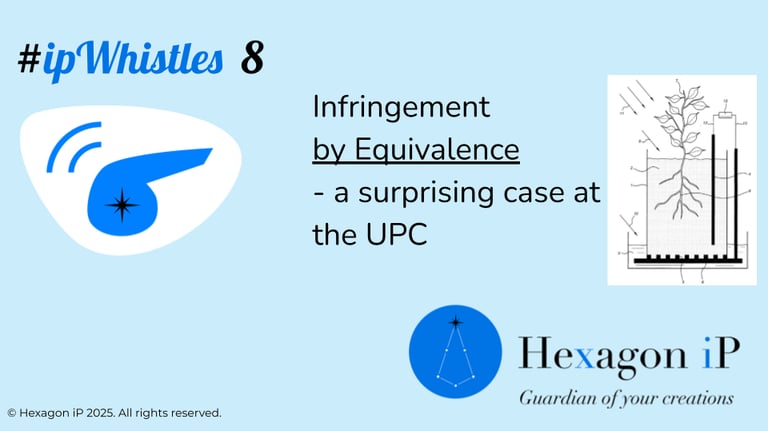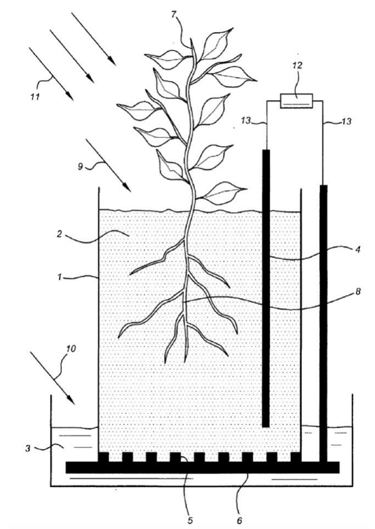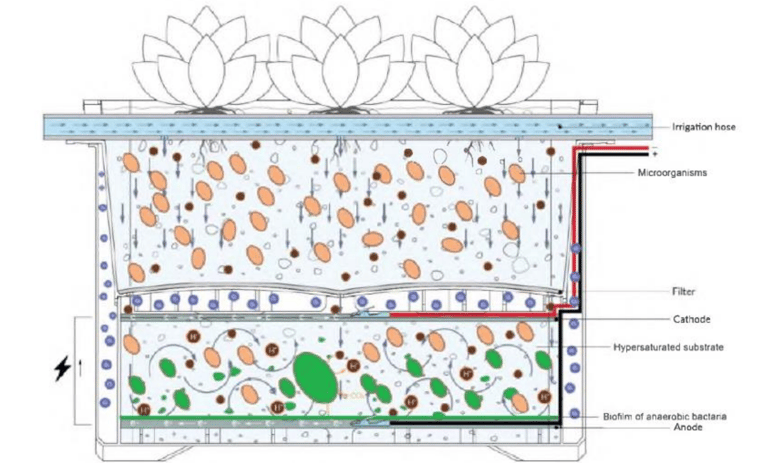Infringement by Equivalence - a surprising case at the UPC
Hexagon iP
8/29/20257 min leer
Infringement by equivalence; Is the patent system in danger with this decision from the UPC?
I recently read this decision from the newly created Unitary Patent Court (UPC). The decision is very interesting because it tackles a long debated topic: “infringement by equivalence”.
The application of this concept in this decision really makes me think: can we still be confident in our analysis of patent claims? Can we really, with such a broad interpretation of equivalence, determine freedom to operate?
Let’s see what happened. This is Plant-e vs Bioo.
. Plant-e filed a patent application for a soil battery (SMFC). Except this time Plant-e added a plant in the soil so that byproducts of the plant are released in the soil. These byproducts are the energy source for micro-organisms that release electrons in the process. An anode is placed in the soil where the plant and the micro-organisms live to close an electrical circuit and produce an electrical voltage. Interesting technology.
The prior art to this patent seems to describe soil batteries (SMFC), but no plant. So Plant-e invented a new battery type the Plant-MFC (PMFC).
Some events happened, like Bioo obtaining a license for Plant-e’s patent and then abandoning it.
. Then Bioo filed its own patent application and commercialized a product based on its patent. The invention is an improvement of the PMFC concept of Plant-e.
I’ll make a short divagation here: it’s not because you have a patent that you are free to use your invention! Your invention may be an improvement of the invention of a previous, overarching patent of another person, and so you still are dependent on this patent. I am not saying it is the case here, but I’ll take any occasion to remind this difficult aspect of patent law.
So, back to our soil batteries. In the patent of Bioo the plant-soil-compartment arrangement is different. The embodiment accused of infringement by Bioo is described in the following figure. In this embodiment, the plants are in an upper compartment, separated from a bottom compartment, the bottom compartment being the battery as such.
Now the Court.
. Feature 11.6
The judgment was all about claim 11 of Plant-e’s patent. In this claim, there is one feature that is central in my opinion. This is feature 11.6:
“wherein the microorganism lives around the root (8) zone of the plant or part thereof.”
It goes together with previous feature 11.4:
“wherein the anode compartment comprises an anodophilic microorganism capable of oxidizing an electron donor compound”
So in short: the roots of the plants are in an anode compartment with anodophilic microorganism in the same compartment, such that the microorganism lives around the root (8) of the plant.
. Some psychology
As a preamble, I want to mention that the defense of Bioo is surprising. It is aggressive, probably too much. It is so aggressive that it uses arguments that are excessive and easily demonstrated to be false. Some psychology would surely highlight that this bad faith annoyed the members of the Court. This is reflected in point 96 of the decision, where the Court mentions that Bioo’s argument ‘does not strike the Court as very realistic’.
A first example of these excessive arguments is Bioo arguing that its device does not need plants (!). This is non-sense and the Court had no difficulty to understand that.
Another surprising example is when Bioo argues that there is no connection between the upper and lower compartments. It is impossible to sustain, as demonstrated by Plant-e: pouring water in the upper compartment shows that the water filters through the bottom compartment.
These aggressive arguments probably induced the Court to think that Bioo was acting in bad faith. While honestly, the argumentation could and should have remained on the fact that Plant-e’s patent did not encompass Bioo’s embodiment. And I believe Bioo had good arguments to demonstrate that its embodiment was simply not within the scope of Plant-e’s patent.
. Infringement.
In the decision points 82-84 the Court confirms that Bioo does not reproduce feature 11.6. As a consequence it does not infringe the patent (literally).
But then, the Court analyses infringement by equivalence.
Infringement by equivalence is a complex topic, with different interpretations depending on the courts and on the countries. Basically it is based on the principle that a patent scope of protection may, in some cases, be somewhat broader that the strict literality of its claims. For example:
- a patent is granted with a claim for a device with a nail as a fastener,
- 5 years later the screw is invented as a new fastener,
- someone reproducing the patent claim with the only difference that it uses the screw instead of the nail would be infringing – by equivalence.
So the court analyzes the infringement by equivalence applying four different criteria which can be summarized as follow:
1. Technical equivalence: does the variant perform the same function?
2. Fair Protection: is it fair for the patentee to extend the scope to equivalents, given their contribution to the art?
3. Legal certainty for third parties: would the skilled person understand, upon reading the patent, that the scope of the invention is broader than what is literally claimed?
4. Patentability of the equivalent: was the equivalent patentable at the patent filing date?
The Court concludes to equivalence without much argumentation in point 97 (emphasis added): “The set up of the Bioo Panel is thus considered technically equivalent to the teaching of the patent as the plant is part of the reactor and is a source of additional organic material for the battery. (…) The plant in the Bioo Panel has the same function as in the claim and solves the same problem. It does this in a similar way, the only difference being an extra compartment which does not affect the function of the plant and is deemed to be equivalent. The same applies to the location of the roots/micro-organism.” The last sentence is particularly striking by its shortness while this is where feature 11.6 resides.
Surprisingly, in its analysis the Court only discussed the presence and the function of the plant. The Court considers that the mere reproduction of the general “idea” of Plant-e, ‘adding a plant to a soil battery’ to form a P-MFC (see point 98), is enough to protect any similar embodiment. The Court mainly bases its reasoning on question 2 whereby because Plant-e’s patent taught the benefit of adding a plant to a soil battery, it would get protection for any PMFC.
In my opinion, the absence of prior art (contested by Bioo) that would describe the use of a plant in a soil battery should not give Plant-e’s patent a scope so as to cover any such device. For some reason which we ignore, when the patent of Plant-e was drafted, a choice has been made to limit its claims to a certain scope of protection. This choice cannot be changed years after, to the prejudice of the public, and even less once a competitor has arisen. It is not because this patent ‘taught’ that a plant in the soil improves the functioning of the battery that it automatically protects any embodiment outside the scope of the claims. The claims drafting should have been broader if such protection was sought.
The Court also did not demonstrate how the fact that the roots are not in the same compartment as the microorganism would be an equivalent of having the roots in contact with the microorganisms (feature 11.6). The Court simply mentions in 98: “It is also obvious (…) to apply the equivalent element, i.e. by separating the plant with roots from the anode compartment”.
However, the patent of Plant-e indicates in the description, at [0019], that “The micro-organism that converts the electron donor compound of the plant (…) preferably lives around the root zone of the living plant (called the rhizosphere), so the micro-organism can release electrons to the anode more easily.”. This seems to me like feature 11.6 is described as essential in this patent and the skilled person reading this would consider that separating the plant’s roots from the micro-organisms and the anode would affect the good functioning of the battery. This contradicts the argumentation of the Court in point 100 whereby “the teaching of the patent is (clearly) broader than the wording of the claim and there is, still in the eyes of the skilled person, no good reason to limit the scope of protection of the claim”; yes there is a reason: and it is at [0019] !
. Risks for the patent system
This decision is making analyses of granted patents and freedom to operate at risk. It brings uncertainty where there should be some reasonable expectations of legal security.
Does this decision mean that every patent scope must now be reviewed not only taking into account its claims and what could reasonably be covered by the claims, but also by reviewing all prior art and guessing what the patent may also cover - non-claimed embodiments that were not present in the prior art? This is putting a huge burden on the public.
This would be a shift for third-parties and clearly would impact any industry and innovator.
En Hexagon iP te ayudamos a entender cómo proteger tu innovación y como evitar riesgos de infracción. Si tienes dudas sobre tu patente o la de un competidor, contáctanos.






Encuentra más información de propiedad intelectual en nuestro blog: #ipWhistles
Contactanos:
hexagon@hexagon-ip.es
+34 604 81 61 25
© 2025. All rights reserved.
Hexagon iP and its logo are registered Trademark
!Síguenos en Linkedin y aprende sobre iP!

